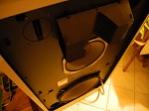.
I'm frequently presented with receivers/amps on a "buy or not - now" situation
without web access.
To guess the WPC , I generally look at the backside for max power consumption , then
divide that number by 3 . Figuring 1/3 for running the gear and 1/3 for output wattage per channel. IE: if the label says 300 watts , I ASSUME about 100wpc.
This method usually is somewhat close. This week I ran across a Realistic receiver (yeah, I know) that was marked "200 watts" , so using my guide I guessed that it output about 60WPC. Got home and checked , RS says 16 WPC (minimum).
Questions: Does that amp really squander 168 watts just to run itself ? Is my guideline for guessing what is generally used , or is there a better one ?
I do realize that the rated draw is not a constant number , but a maximum, as is the power output number a minimum (in this case)
anyone ?




 Reply With Quote
Reply With Quote



 (generally) , tho it sounds like front panel stickers don't even agree with owners manual on the same product.
(generally) , tho it sounds like front panel stickers don't even agree with owners manual on the same product.

